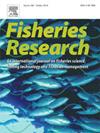Making do with less: Extending an acoustic-based time series of euphausiid abundance using an uncrewed surface vehicle with fewer frequencies
IF 2.2
2区 农林科学
Q2 FISHERIES
引用次数: 0
Abstract
Survey time series are used to track species- and ecosystem-level trends over time to support ecosystem-based fishery management. However, these recurring survey efforts are subject to unpredictable cancellations and reductions in effort. This occurred in 2020 when the COVID-19 pandemic forced the cancellation of the research vessel-based 2020 eastern Bering Sea (EBS) acoustic-trawl survey, which has provided an estimate of euphausiid abundance and distribution since 2004. As a partial replacement for this lost effort, three uncrewed surface vehicles (USVs) were used to collect acoustic data. In contrast to the standard vessel-based survey, which provides 4-frequency acoustic data, the USVs collected acoustic data at only two frequencies. This presented a challenge given that four frequencies are currently used to identify euphausiids in this time series. Here, we first evaluated two methods to provide comparable euphausiid abundance estimates using fewer acoustic frequencies. We found that a random forest classifier was able to produce abundance estimates comparable to those obtained in the vessel-based time series. This method was then used to estimate euphausiid abundance and distribution from the 2020 USV survey. We additionally estimated the increase in survey uncertainty due to the use of the random forest classifier and changes in the acoustic instruments. Together, this allowed for the EBS euphausiid abundance time series to be extended with fewer acoustic frequencies.
求助全文
约1分钟内获得全文
求助全文
来源期刊

Fisheries Research
农林科学-渔业
CiteScore
4.50
自引率
16.70%
发文量
294
审稿时长
15 weeks
期刊介绍:
This journal provides an international forum for the publication of papers in the areas of fisheries science, fishing technology, fisheries management and relevant socio-economics. The scope covers fisheries in salt, brackish and freshwater systems, and all aspects of associated ecology, environmental aspects of fisheries, and economics. Both theoretical and practical papers are acceptable, including laboratory and field experimental studies relevant to fisheries. Papers on the conservation of exploitable living resources are welcome. Review and Viewpoint articles are also published. As the specified areas inevitably impinge on and interrelate with each other, the approach of the journal is multidisciplinary, and authors are encouraged to emphasise the relevance of their own work to that of other disciplines. The journal is intended for fisheries scientists, biological oceanographers, gear technologists, economists, managers, administrators, policy makers and legislators.
 求助内容:
求助内容: 应助结果提醒方式:
应助结果提醒方式:


